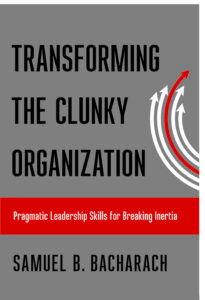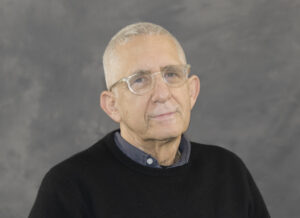Leadership Skills for Breaking Inertia
One of my favorite leadership thinkers is Samuel Bacharach. Not only is he a regular columnist for Inc., an author, and a leadership speaker, but he is also the McKelvey-Grant Professor at Cornell University.
He recently released a book that I found to be an incredible addition to my leadership library. Transforming the Clunky Organization: Pragmatic Leadership Skills for Breaking Inertia is one of those books that will inspire both new and seasoned leaders with its practical advice and unique perspective.
If your organization is stuck and you need to break inertia and foster innovation, I can think of no better place to start than with this book.
Advance the Agenda
Why this book on leadership and why now?
In the last number of years there has been massive growth in books about leadership and trainings in leadership, but one fundamental question is not asked: What is it in an organizational context do we want leaders to accomplish?
If we are going to train and educate people in leadership, it has to be for a purpose. In an organizational context, that focus has to be on the capacity of people to come up with ideas, move ideas, implement them, create change and innovation, and get things done. In this context, what is important to me is pragmatic leadership—that is, the simple and clear tasks of execution. Not execution as global promise but as a series of skills that can be followed and achieved for results.
In The Agenda Mover: When Your Good Idea Is Not Enough, I discussed the micro-political skills that leaders at levels need to move their agenda: creating coalitions, overcoming resistance, negotiating, and establishing credibility. These often-ignored political skills were the focus of this volume.
Over the last three years I have been focusing on the question, “What do I want leaders to accomplish?” In my experience of some forty-odd years, I realize that great leaders are those who begin to have the sense of when their organization becomes stuck, sluggish, and trapped by inertia. Great leaders break inertia. They appreciate the dangers of inertia and do something about it. They also understand that organizations may be sluggish and in the doldrums of inertia, even though they continue functioning. These leaders understand that although inertia may not necessarily lead to immediate failure, inertia may impede their organization’s capacity to reach its potential. Transforming the Clunky Organization focuses on the characteristics of organizations that get trapped by inertia and, in turn, suggests leadership skills and strategies leaders can use to overcome sluggishness and inertia.
Why Organizations Become Sluggish
What are a few reasons causing organizations to become sluggish?
Organizations get stuck because of sluggishness and inertia. Great leaders know how to break inertia. Basically, there are two fundamental reasons why organizations become sluggish: they are either clunky or myopic.
We are all familiar with clunky organizations. They are large and complex. Many times they are global in nature. And embedded in the organization are multiple priorities, competing missions, looking from the outside in, and appear to be chaotic in nature. It is important to remember that clunky organizations can be meeting external benchmarks of success, but at the same time, may find it difficult to reach their potential. A clunky organization finds it difficult to be agile and quickly respond to market challenges. Dell Technologies Inc., before going private, was a prototypical clunky organization. In fact, it may be argued that going private was a response by Dell’s leaders to address and correct the organization’s clunky tendencies.
Organizations also become sluggish due to their myopic tendencies. Instead of being all over the map like a clunky organization, myopic organizations often rely on old business models and have a hyper-focus. They fail to pick strong and weak signals and are resistant to recognizing market trends that may threaten their core business. A prime example of a myopic organization is Kodak, especially with regard to its longstanding hesitation to enter into the digital film market. In a bid to preserve its film business, the organization refused to seriously develop digital photography, even though a Kodak engineer was the first to develop a filmless camera.
How does a leader assess the organization and determine whether, and which, type of organizational inertia they are facing?
While numerous questions can be asked and a number of assessments can be conducted, let me give you an example of some broad questions that can emerge.
To address the clunky tendency, organizational leaders can ask themselves: Are the business units integrated? Are the lines of decision-making authority clear? Is there ambiguity or a lack of goal alignment? Are there issues of turf that can lead to communication breakdown?
In thinking about the myopic tendency, organizational leaders can ask themselves: Is the organization driven by one product or mindset? Is there tight central control of the core mission? Is it difficult to develop new products and explore new markets? Is the general organizational culture risk-adverse?
Once a leader is familiar with the notion of clunky and myopic organizations, it is fairly straightforward to conduct a self-assessment. The danger, of course, is to assume that organizations are one or the other. Organizations may indeed have both clunky and myopic tendencies. The challenge is to understand which sector or sectors of the organization where each theme emerges.
Overcome Headwinds
How does a leader overcome various headwinds of resistance that slow forward movement?
This really is the core leadership question for me. Indeed, fighting headwinds and overcoming inertia is the critical pragmatic activity that all leaders of the organization should be focused on.
As argued in Transforming the Clunky Organization, leaders must engage in robust discovery and focused delivery to break inertia. Discovery is about exploring the context and facilitating ideation. One way to engage in exploration is to read weak and strong signals. An example of reading weak signals is with Lululemon. The founder of the organization was taking a yoga class and noticed that others in the class were wearing sloppy exercise clothes. Of course, at that time, there was no market for yoga pants, but he created a market for them. He was just living his life, and he made a notable discovery—not only that yoga was growing in popularity, but also that its practitioners would want to expand their exercise wardrobe.
The second component of discovery is facilitating ideation. Leaders need to support their team in coming up with a range of ideas. Leaders help their teams cut through the noise and help them prioritize and identify the best ideas to move to prototype. IDEO has developed a strategy for idea selection. First, they help their client organization define the scope of the problem being addressed. Would it be to design one specific product, or it is something more ambitious? Knowing the size of the canvas is essential to moving forward. IDEO taps team members from diverse backgrounds on projects, and after observing the client organization in action, the team comes together to brainstorm solutions. This is the divergence stage. All ideas are on the table. The next stage of ideation is convergence, which is the winnowing. The team narrows down the list to the ideas that have the most promise. Sometimes ideas are combined, and everyone votes on which idea moves to prototype. IDEO’s approach and institutionalization of divergent and convergent thinking helps them to break inertia.
Delivery is about moving ideas to reality. And in an organizational context, leaders need to campaign for support and sustain momentum. It means turning that idea that emerged during the discovery phase into reality. Leaders know that they can’t do it alone and they need the assistance of others in the organization.
One leader who was an expert in campaigning for support was Lee Iacocca in getting the Mustang on the road, so to speak. As freshly minted general manager, Iacocca was a gatekeeper. The power of a gatekeeper is diffuse and fragmented, and they are often the link to the top dog—that is, the CEO or others in the C-suite. To pursue the new car project, Iacocca brought together the best engineers—the organizational gurus—the ones with specialized knowledge and expertise—and worked with them in the mostly secret development phase. He also needed to get Ford’s players on board. Every organization has players, who are the people who can influence how an agenda is executed. Iacocca held a contest for the best design, and he spurred the excitement of the designers and engineers in the project. Lastly, Iacocca had to convince top dog Henry Ford II. Ford was still stinging from the Edsel flop, and was not very willing to enter, let alone create, a new market for a sporty car. Iacocca had to convince him that the project was worth pursing to the end, and in the end, and a little reluctantly, Ford gave his approval, and the Mustang is a legend.
Sustaining momentum is about finding the best balance between tight and loose control. Organizations like Walmart are known for their tight centralized control, and organizations like Zappos are known for their extremely loose, free-wheeling system of management. A forerunner in balancing control was Alfred Sloan of GM. He managed tightly at the center, with regard to strategy and resource allocation, but he allowed the units to operate more loosely. Apple is an organization that is known for its tight control, but when they are developing a new product, the reins are loosened, and the project teams have the freedom to create and discover. Sloan and Jobs effectively balanced tight and loose structures, staving off inertia.
Break Inertia
What challenges do leaders face to break inertia?
Above we discussed what leaders have to do to overcome the headwinds of inertia, but I think there is another challenge, and I think this questions address that. I think leaders need to balance discovery and delivery. There are leaders who focus on discovery but failure to understand the complications and resistance that need to be overcome to deliver. And then there are those leaders who are obsessed with delivery. They never ask what they are delivering, and how this works in the context of customers, the market, industry trends, and technological innovation. They deliver simply to get the credit for having done something. The first challenge is to be able to balance discovery and delivery.
The second challenge is how to remain mindful of the core skills. We’ve discussed the core skills of discovery, exploring the context and facilitating ideation, and the skills of delivery, campaign for supporting and sustaining momentum. Organizations fail to overcome inertia because their leaders don’t take the skills seriously and are not mindful and focused on the specific things they need to do. They lead in a sprawling manner rather than in a focused, pragmatic, engaged way. The skills of discovery and delivery alone will never overcome inertia unless leaders understand they must mindfully execute.
In what ways can a leader sustain both discovery and delivery so that the organization continues its transformation?
 The relationship between discovery and delivery is ongoing. One of the great ironies of organizational life is that yesterday’s delivery becomes today’s inertia. There is a certain ebb and flow between discovery and delivery, a certain dialectic. On the one hand, leaders must be keenly aware at what point the deliverables become stale and renewed discovery is necessary. And on the other hand, they have to realize when discovery and new insights are irrelevant, inconsistent, and unlikely to result in delivery. Sometimes leaders jump on ideas too soon. That is, some ideas need time to bake before they are ready to be moved into the organization.
The relationship between discovery and delivery is ongoing. One of the great ironies of organizational life is that yesterday’s delivery becomes today’s inertia. There is a certain ebb and flow between discovery and delivery, a certain dialectic. On the one hand, leaders must be keenly aware at what point the deliverables become stale and renewed discovery is necessary. And on the other hand, they have to realize when discovery and new insights are irrelevant, inconsistent, and unlikely to result in delivery. Sometimes leaders jump on ideas too soon. That is, some ideas need time to bake before they are ready to be moved into the organization.
So it’s a perpetual balance of knowing when to move beyond today’s deliverables and being aware when certain discoveries and insights are not ready or worthy of pursuing.
For more information, see The Agenda Mover: When Your Good Idea Is Not Enough and Transforming the Clunky Organization: Pragmatic Leadership Skills for Breaking Inertia.

